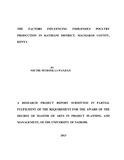| dc.description.abstract | Although the livestock sector is the main source of livelihood and especially in the arid
and semi arid districts (ASALs) and employ about 50 percent of the labour force,
exploitation of the livestock subsector has been faced with many challenges and
constraints. These include socio economic factors, technological factors, low
productivity, policy and legal frameworks, erratic and unpredictable weather, prevalence
of trans-boundary animal and zoonotic diseases and pests, inadequate capacity for service
delivery, weak delivery of extension services, and demographic factors among others.
The purpose of this study was to determine the factors influencing indigenous poultry
production in Kathiani District. The study then would give recommendations to the
relevant authorities and the indigenous poultry keepers to address those factors aimed at
increasing indigenous poultry production in the District and subsequently improving the
standard of living of the community through poverty reduction. The research was
conducted by collecting primary and secondary data. Primary data was collected from
small scale indigenous poultry farmers in the district with the help of divisional livestock
officers working in the target area and who were involved in livestock extension and are
conversant with the area. Pre testing of the questionnaire was done in one of the locations
not sampled in the district before actual administering in the field. The data was then
collected using personal interview. A semi structured questionnaire was used to collect
the data during the interview. The sampling procedure was multi stage sampling method.
The analysis was mainly descriptive in form of frequencies and percentages. The major
analysis method was Logistic regression using SPSS. From the study, technological
factors, demographic factors as well as social economic factors influenced indigenous
poultry production in Kathiani district albeit differently. Trainings on indigenous poultry
management practices, disease management (NeD and diarrhea control) and cock
management significantly influenced indigenous poultry production in the district. The
recommendation of the study was that government policies should be changed to allow
for more employment of more staff to ensure that more livestock farmers are trained as
41% had not been trained. Policy makers should formulate policies aimed at addressing
the livestock breeding and livestock diseases control to cushion the farmers from
expensive private practitioners as majority, 77% of the respondents said that they do not
consult the veterinarian because they are expensive. Further research to establish the
reasons why more females owned indigenous poultry than males as found out from the
study should be conducted. The findings showed that 57% of the indigenous local poultry
is owned by the wife, 33% is owned by the husband while as 10% is owned by the both
wife and husband. | en |

